There is a "Good" and a "Bad", no "Ugly", to being a character actor. The "Good" is the many roles you get to portray, but "The Bad" is you never get the pay scale of the stars, or co-stars. However, as with the two roles mentioned above. You sometimes have a role that decades later is still remembered and talked about by the picture's audience old, or new and outshines the stars..
Dwight lliff Frye was born February 22, 1899 in Salina, Kansas. As a student Frye studied music and was actually a concert pianist.

He switched to acting on the legitimate stage and made a name for himself in comedy. Frye's first motion picture appearance was in the silent film "Exit Smiling". The feature starred popular comedian Beatrice Lillie and Mary Pickford's younger brother Jack Pickford. The movie has a dream sequence in which Beatrice Lillie's "Violet" sees herself as an accomplished stage actress. Dwight Fry's role simply reads "Heckler in the Balcony". One can wonder how you can "Heckle" someone in a silent film up in the balcony.
Two forgotten silent films later, along with legitimate stage performances, and Dwight Frye was in his first sound motion picture/ Released October 18, 1930 "The Doorway to Hell" was another pre-Motion Picture Code Gangster movie starring the future "Dr. Kildare" Lew Ayers and featuring, in his second movie a young James Cagney. Who was a year away from "Public Enemy" and a jump to stardom. Frye portrayed a gangster named "Monk".

Dwight Frye is on the left above and with James Cagney in the following two scenes.

Another forgotten revenge film in 1930 and then the role of a "Real Estate Agent" in a film from Horror director Tod Browning.`
The above title card says it all. The premiere audience saw the feature on February 12, 1931 in New York City and the general release date was two days later. Dwight Frye was about to be seen in one of his two most memorable roles, both in 1931, as "R.M. Renfeld" described by author Bram Stoker:
R. M. Renfield, aetat 59. Sanguine temperament, great physical strength, morbidly excitable, periods of gloom, ending in some fixed idea which I cannot make out. I presume that the sanguine temperament itself and the disturbing influence end in a mentally-accomplished finish, a possibly dangerous man, probably dangerous if unselfish. In selfish men, caution is as secure an armour for their foes as for themselves. What I think of on this point is, when self is the fixed point the centripetal force is balanced with the centrifugal. When duty, a cause, etc., is the fixed point, the latter force is paramount, and only accident or a series of accidents can balance it. — From Dr. John Seward's journalWhen the audience first sees "Renfeld" he is a passenger on a bumpy coach ride to a Transylvanian Village. The lady who has fallen into Frye's lap is Carla Laemmle. Carla was the Cousin of the films producer Carl Laemmle, Jr. and as such the niece of his father Universal studio owner Carl Laemmle.
At the village "Renfeld" announces he needs the coach to take him to the Borgo Pass to meet another coach from "Count Dracula".
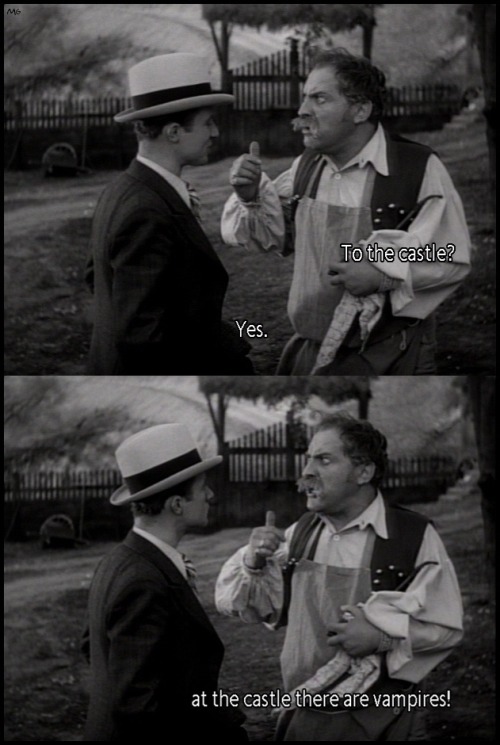
"Renfeld" is taken to the pass and meets with the coach actually driven by "Count Dracula" played famously by Bela Lugosi. However, Lugosi wasn't the first choice for the role. He was the eighth and although Bela had been thrilling and frightening audiences for two years on Broadway. The following actors were considered, before offering the role to Lugosi. Paul Muni, Chester Morris, Iam Keith, John Wray, Joseph Schildkraut, Arthur Edmond Carewe and William Courtenay, all established film actors at the time.
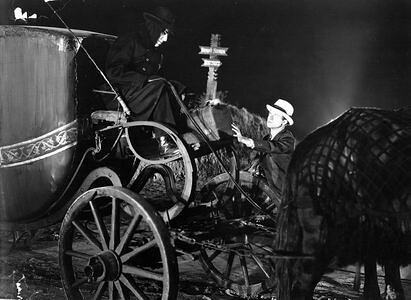
Arriving at Castle Dracula, "Renfeld" meets the Count. Who seems to have walked through cobwebs without disturbing them, but "Renfeld" has to break them apart with his cane.
At a table set for the Real Estate agent "Renfeld" cuts himself and "Dracula" almost looses complete control of himself.
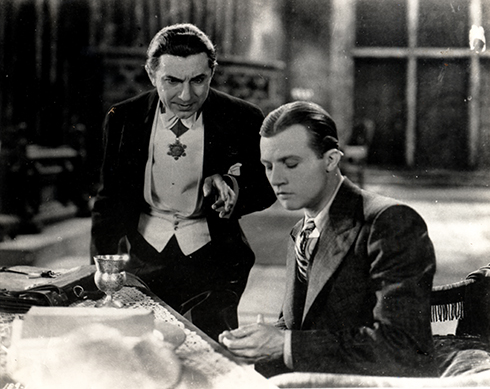
Ever note that in the above scene it appears Lugosi is wearing a "Star of David"?
After getting the papers signed for Carfax Abby "Dracula" hypnotizes "Renfeld".and he faints. The three wives of the Count want to feast upon him, but "Dracula" chases them away and drinks "Renfeld's" blood turning him not into a vampire, but his slave.
When the ship carrying the Count arrives in England. The only living person left on board is the now crazed "Renfeld". At this point Dwight Frye started a "Tour De Force" performance etched into the minds of the audience. As he steals the movie from under the other actors.
Below the crazed "Renfeld" is in "Dr. Seward's" Insane Asylum.

The sequence were "Renfeld" is taken to see "Dr. Seward" and meet "Professor. Van Helsing" is classic scene stealing.

Frye above with Charles K. Gerrard as "Martin, Renfeld's Attendant" and Edward Van Sloan as "Professor Van Helsing". Below Frye with Herbert Bunston as "Dr. Steward".

Below Frye with Edward van Sloan's "Dr. van Helsing".

In "Dracula" Dwight Frye had been billed fourth.

Mention "The Maltese Falcon" and the names Humphrey Bogart, Mary Astor, Sydney Greenstreet and Peter Lorre immediately come to mind. However, director John Huston's 1941 film noir was the third version of Dashiell Hammett's novel., The first had been released ten years earlier on June 13, 1931.
Dwight Frye moved from fourth billing down to ninth as "Wilmer Cook". The star of the feature was
very popular actress Bebe Daniels as "Ruth Wonderly" and Ricardo Cortez, another popular actor, was "Sam Spade".


Above Cortez and Daniels. Below Dwight Frye as a somewhat psychotic "Wilmer Cook".

The 1931 "Maltese Falcon" was pre-Motion Picture Code and the characters are very close to those as written by Dashiell Hammett and the themes of the screenplay leave nothing out unlike the two following versions. There are even scenes with Bebbe Daniels in full nudity in this original release.
On the far left, below, is actor Otto Matieson as "Dr. Joe Cario". "Sam Spade" describes "Cario" as "Gorgeous" and the character is played very obviously gay. As compared to the overt censorship of 1941 and Peter Lorre's "Cario". Whose mannerisms might suggest homosexuality, but is never said outright in the dialogue. On the far right is Didley Diggers as "Casper Gutman". "Wilmer" is referred to as "Gutman's Boyfriend" in the picture.
As in the other two film versions and the novel. "Wilmer Cook" is informed he is to be sacrificed to the police to protect everyone else. In the end "Ruth Wonderly" actually ends up in prison and "Sam Spade" visits her.
Those pre-code themes in the 1931 film stopped Warner Brothers Studio from releasing the motion picture in 1936 with and enforced code in place So they remade it as "Satan Met A Lady" released July 22, 1936 starring Bette Davis and Warren Williams, but changed the names of all the characters to be sure to get around the Hayes Censorship Office. My article is "The Stuff That Dreams Are Made Of': The Maltese Falcon in Writing and on the Motion Picture Screen" at:
Those pre-code themes in the 1931 film stopped Warner Brothers Studio from releasing the motion picture in 1936 with and enforced code in place So they remade it as "Satan Met A Lady" released July 22, 1936 starring Bette Davis and Warren Williams, but changed the names of all the characters to be sure to get around the Hayes Censorship Office. My article is "The Stuff That Dreams Are Made Of': The Maltese Falcon in Writing and on the Motion Picture Screen" at:
http://www.bewaretheblog.com/2018/03/the-stuff-that-dreams-are-made-of.html
Dwight Frye's third motion picture of 1931 was released on June 21, 1931. "The Black Camel" was the second motion picture to star Warner Oland as Hawaiian Chinese Detective "Charlie Chan". The movie featured Bela Lugosi and introduced Robert Young. Dwight Frye was without on screen credit as "Jessop" the butler. He is seen below with Lugosi and Robert Homans.

Then on November 21, 1931 Dwight Frye went from director Tod Browning to director James Whale.

On the original poster for James Whale's classic "Frankenstein" is the complete screenplay title "Frankenstein The Man Who Made A Monster". Also the poster indicates Dwight Frye with fifth billing behind Boris Karloff. The actual screen credits has Frye listed as seventh behind actor Frederick Kerr as "Baron Frankenstein" the father of "Henry", actor Colin Clive.
No matter what his actual billing. Dwight Frye created a character in "Frtiz" that is still copied today and for three decades a mad scientist had to have a hunchback assistant, or he wasn't mad enough..

Below "Henry" and "Fritz" take down the corpse that will become the monster. Director James Whale and Art Director Charles D. Hall created a black and white vision of shadows and imagery captured by Cinematographers Arthur Edeson and Paul Ivano that still haunt us today.

Below, "Fritz"is about to be scared and drop the good brain and take the abnormal one instead.

"Henry" and "Fritz" use electricity to bring the monster to life and shortly thereafter the audience hears Colin Clive declare "IT'S ALIVE".

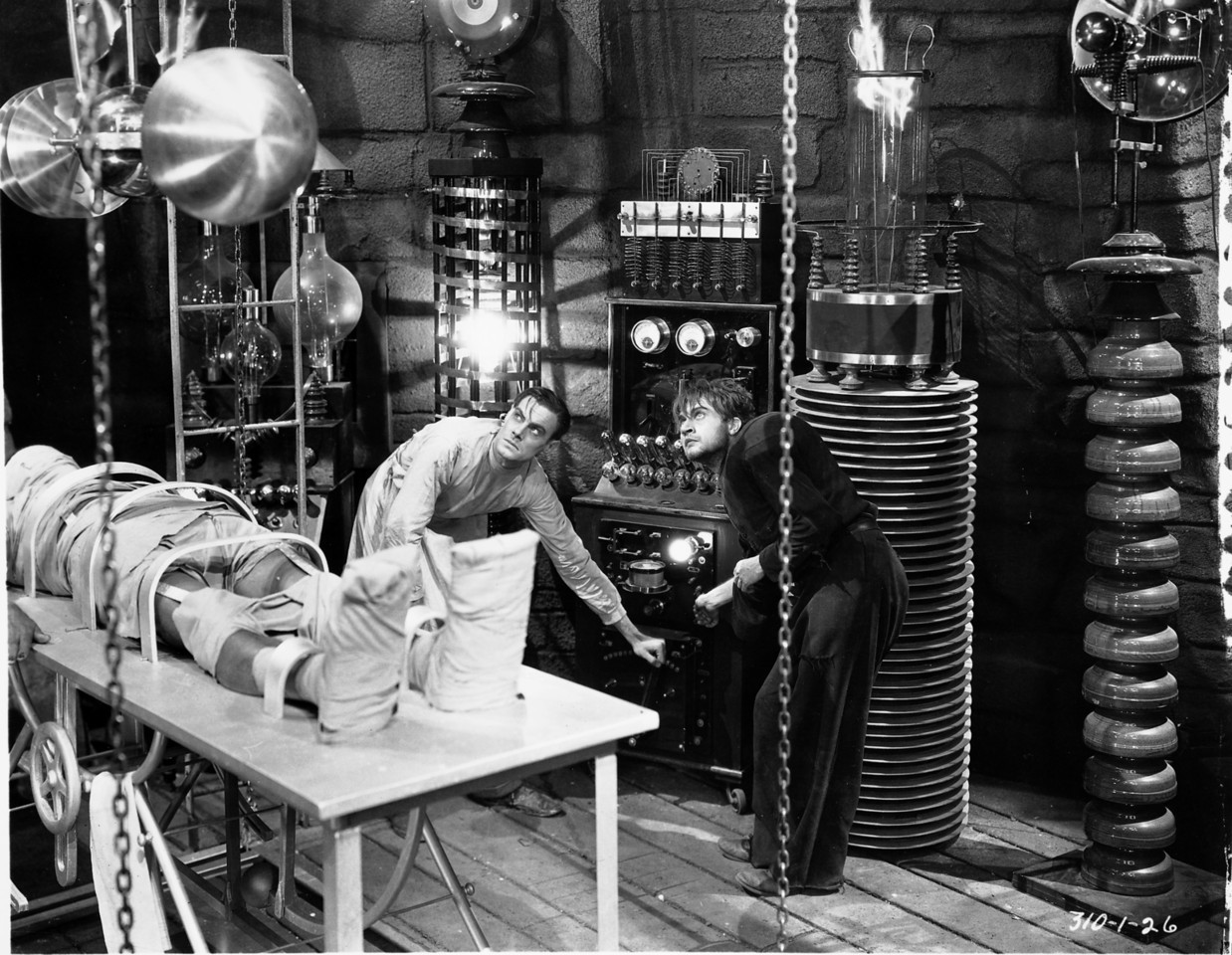

Two 1932 forgotten detective films followed with "Attorney for the Defense" and "By Whose Hand" and Dwight Frye found himself in his only Western starring "Colonel Tim McCoy". "The Western Code" was released on September 16, 1932.

Above Nora Lane as "Polly Lumas", Tim McCoy as Texas Ranger "Tim Barrett" and Dwight Frye as "Polly's" brother "Dick Lumas". Both "Polly" and "Dick" have been cheated out of their inheritance with a fake will and blamed for a murder by a man named "Chapman", portrayed by Mischa Auer, and "Nick Grindell" played by Wheeler Oakman.
Seen below is the climax scene from the Who-Done-It "A Strange Adventure" aka: "The Wayne Murder Case" released November 20, 1932.

Above left to right, Nadine Dore portraying "Gloria Dryden", Dwight Frye portraying "Robert Wayne", and Regis Toomey portraying "Detective-Sergeant Mitchell".
Dwight Frye's third motion picture of 1931 was released on June 21, 1931. "The Black Camel" was the second motion picture to star Warner Oland as Hawaiian Chinese Detective "Charlie Chan". The movie featured Bela Lugosi and introduced Robert Young. Dwight Frye was without on screen credit as "Jessop" the butler. He is seen below with Lugosi and Robert Homans.

Then on November 21, 1931 Dwight Frye went from director Tod Browning to director James Whale.

On the original poster for James Whale's classic "Frankenstein" is the complete screenplay title "Frankenstein The Man Who Made A Monster". Also the poster indicates Dwight Frye with fifth billing behind Boris Karloff. The actual screen credits has Frye listed as seventh behind actor Frederick Kerr as "Baron Frankenstein" the father of "Henry", actor Colin Clive.
No matter what his actual billing. Dwight Frye created a character in "Frtiz" that is still copied today and for three decades a mad scientist had to have a hunchback assistant, or he wasn't mad enough..

Below "Henry" and "Fritz" take down the corpse that will become the monster. Director James Whale and Art Director Charles D. Hall created a black and white vision of shadows and imagery captured by Cinematographers Arthur Edeson and Paul Ivano that still haunt us today.

Below, "Fritz"is about to be scared and drop the good brain and take the abnormal one instead.

"Henry" and "Fritz" use electricity to bring the monster to life and shortly thereafter the audience hears Colin Clive declare "IT'S ALIVE".



Two 1932 forgotten detective films followed with "Attorney for the Defense" and "By Whose Hand" and Dwight Frye found himself in his only Western starring "Colonel Tim McCoy". "The Western Code" was released on September 16, 1932.

Above Nora Lane as "Polly Lumas", Tim McCoy as Texas Ranger "Tim Barrett" and Dwight Frye as "Polly's" brother "Dick Lumas". Both "Polly" and "Dick" have been cheated out of their inheritance with a fake will and blamed for a murder by a man named "Chapman", portrayed by Mischa Auer, and "Nick Grindell" played by Wheeler Oakman.
Seen below is the climax scene from the Who-Done-It "A Strange Adventure" aka: "The Wayne Murder Case" released November 20, 1932.

Above left to right, Nadine Dore portraying "Gloria Dryden", Dwight Frye portraying "Robert Wayne", and Regis Toomey portraying "Detective-Sergeant Mitchell".
Somebody wearing a hood killed "Silas Wayne" and could it be one of the other "Wayne's"? Who are starting to be killed off. Dwight Frye is an obvious possibility, but is the "Red Herring" in the plot. The murderer turns out to be "Dr. Bailey" who was treating "Silas" and is really an unknown "Wayne".
Next Dwight Frye was back in old hunts in "The Devil Bat" released January 21, 1933.
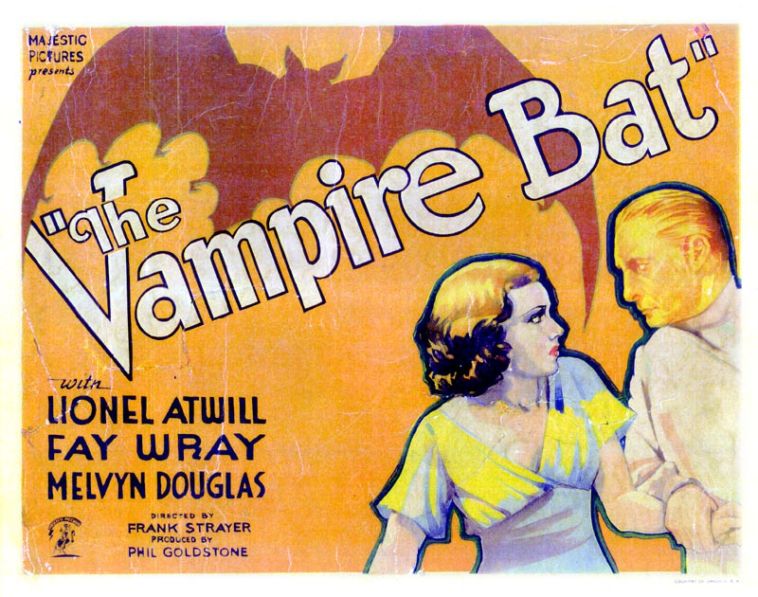
The motion picture starred the Horror team of Fay Wray and Lionel Atwill. They had been seen together in the first all Technicolor Horror movie, 1932's "Dr. X", and would follow this picture in February 1933 with "The Mystery of the Wax Museum". The original version of 1953's "The House of Wax". Then in April 1933 Fay Wray would be seen in a little something called "King Kong".
My article on "Fay Wray Before King Kong" can be read at:
http://www.bewaretheblog.com/2015/11/fay-wray-before-king-kong.html
The villain of the piece is of course Lionel Atwill as "Dr. Otto van Niemann". Fay Wray is the heroine "Ruth Bertin".

Melvyn Douglas is our hero "Karl Breettschneider"..
Dwight Frye was billed 6th as "Herman Gleib".

People in the village of Kleinschoss are being found dead from loss of blood. The village elders believe there is a vampire at loose and must be found and destroyed."Herman Gleib" is believed to be involved, because he always has been strange. In the end "Gleib" is killed by the vampire which is not really a vampire in the legend sense, but "Dr. Niemann" using the blood of the villagers for an artificial life form he's created.
Below Dwight Frye being Dwight Frye.

On April 10, 1933 was a detective mystery starring Adolphe Menjou as New York Police Commissioner "Thatcher Cot" entitled "The Circus Queen Murder".


Above Adolphe Menjoy asa "Cot". He was in the audience when the murder took place. The story revolves around a love triangle of trapeze artists. They are "Josie La Tour", seen dead above, her lover "The Great Sebastian" and her husband "Flandrin" played by Dwight Frye below.
In the end "Flandrin" being pursued runs into the "Big Top", performs a solo trapeze act and shoots himself to fall to the same floor as his wife.
Don't blink during James Whale's "The Invisible Man", released November 13,1933, or you won't see Dwight Frye, in a non screen credited role of a reporter. However, it was easier to find the actor in James Whale's "The Bride of Frankenstein" released May 6, 1935. In this picture he portrayed "Karl Glutz" with 12th billing.


Don't blink during James Whale's "The Invisible Man", released November 13,1933, or you won't see Dwight Frye, in a non screen credited role of a reporter. However, it was easier to find the actor in James Whale's "The Bride of Frankenstein" released May 6, 1935. In this picture he portrayed "Karl Glutz" with 12th billing.


Above Frye as "Karl Glutz" meeting "Dr. Pretorius" portrayed by Ernest Thesiger. Below Boris Karloff on the far left and Dwight Frye on the far right, with the staff next to Frye, is actor J. Gunnis Davis as "Uncle Glutz".

Below Frye with Valerie Hobson as "Elizabeth Frankenstein".

Below some other shots of Dwight Frye in the James Whale feature film,

Below Frye with Valerie Hobson as "Elizabeth Frankenstein".

Below some other shots of Dwight Frye in the James Whale feature film,
Censorship from the Hayes Office was extremely strict on this production as compared to the pre-Motion Picture Code, 1931, "Frankenstein". As a result several scenes with Dwight Frye's "Karl Glutz" and his "Uncle", portrayed by J. Gunnis Davis, met the editors knife over violence. There are two major sequences, the first of "Karl", referred to as "Nephew Glutz", murdering his Uncle, and a follow up, putting the blame on Karloff's monster, both were removed from the final print. As a result of the removal of these two sequences with Frye. All his other scenes had to be either deleted from the final print, or shorten, to keep the film's continuity. The footage is considered lost and we may never know what this subplot to "The Bride of Frankenstein" looked like and the specific pages to the screenplay are said to be missing also. What is left is a question to the monster's motivation behind, seemingly, just throwing "Karl" off the roof of "Henry Frankenstein's" laboratory.
In the motion picture "Atlantic Adventure", released August 25, 1935.
In the motion picture "Atlantic Adventure", released August 25, 1935.
Second-billed Lloyd Nolan is a newspaper reporter who stows away on an ocean liner to find a murderer and stop a gang of jewel thieve's. His photographer joins him and both are surprised when Nolan's girlfriend, first billed Nancy Carroll, appears also as a stowaway.
Below, Dwight Frye portraying "Spike Jonas", came onboard the ship with his elderly father in a wheel chair, actually a disguised wanted killer.


A movie that claimed to be based, if so very loosely, upon Edgar Allan Poe's "The Premature Burial" entitled "The Crime of Doctor Crespi" was released September 24, 1935.

Actor, director and producer Eric Von Stroheim is "Dr. Crespi". Who created a drug that induces a catatonic state. He injects his enemies with it and then buries them alive. "Dr. Crespi" hates "Dr. Stephen Ross" played by John Bohn. "Ross" married the women "Crespi" loved "Estelle" played by Harriet Russell. So he injects "Ross" with his drug and buries him alive. "Dr. Thomas", played by Dwight Fry, suspects something and exhumes "Ross's" body. Only to have "Ross" come out of the drug on the autopsy table and go after "Crespi".
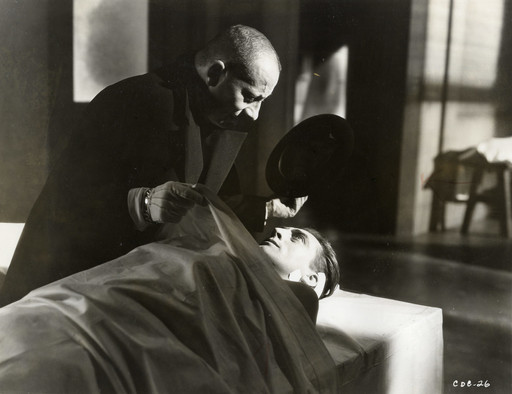
Above Von Stroheim and Bohn. Below Frye as "Dr. Thomas" with Stroheim.


A movie that claimed to be based, if so very loosely, upon Edgar Allan Poe's "The Premature Burial" entitled "The Crime of Doctor Crespi" was released September 24, 1935.

Actor, director and producer Eric Von Stroheim is "Dr. Crespi". Who created a drug that induces a catatonic state. He injects his enemies with it and then buries them alive. "Dr. Crespi" hates "Dr. Stephen Ross" played by John Bohn. "Ross" married the women "Crespi" loved "Estelle" played by Harriet Russell. So he injects "Ross" with his drug and buries him alive. "Dr. Thomas", played by Dwight Fry, suspects something and exhumes "Ross's" body. Only to have "Ross" come out of the drug on the autopsy table and go after "Crespi".

Above Von Stroheim and Bohn. Below Frye as "Dr. Thomas" with Stroheim.
Below. "Dr. Thomas" exhuming the body which looks pretty clean, to me, from having been buried alive.
Two more films without on screen credit and Dwight Frye found himself in a comedy entitled "Florida Special" released April 21, 1936, about jewel thieves on a train.
Five of Dwight Frye's next nine motion picture appearances were small roles without on screen credit. In one of the five, "The Man Who Found Himself", released April 2, 1937, Frye's role was described as the "Hysterical Patient", an obvious type casting part.
That's Joan Fontaine in her fourth screen role and three years away from co-starring with Lawrence Olivier in Alfred Hitchcock's "Rebecca". Frye is the man lying down about to get the point from John Beal's needle.
On September 30, 1937 James Cagney and Evelyn Draw starred in the musical "Something to Sing About". The movie was a satire on the motion picture industry of the time.

Dwight Frye portrayed "Mr. Easton" the studio's make-up supervisor. He's seen below with a young James Cagney.

"The Shadow" premiered December 22, 1937 and was about a young women returning her father's circus to its past glory. When a murder happens in the center ring in front of a packed house.
Rita Cansino had been seen in 14 motion pictures previously, but this was only her sixth appearance using her new screen name of Rita Hayworth.

Another non on screen credited role for Dwight Frye and then ninth billing as "Alex" in the "Invisible Enemy" released April 4, 1938. The title sounds like either a Science Fiction of Horror title, but is about a man stealing industrial secrets for a Foreign Government.

Below Frye as "Alex".

Five motion pictures later and Dwight Frye had the great character name of "Gravet-The Jackel" in "Adventure in Sahara" released November 15, 1938. The feature was about a French Foreign Legion out post with a sadistic commandant. His treatment of his men will finally lead to a mutiny and Frye's "Gravet" is the informer of the mutineers plans. There is also an attack on the out post just after the mutiny by Arabs.
1939 started out with a role that may, or may not have happened.Released on January 13, 1939 was the "Son of Frankenstein". Depending on who was writing about the feature. They state Dwight Frye either was, or was not one of the villagers in the following scene.

What we know for sure was Dwight Frye's next four motion pictures consisted of three without on screen credit and one with his scenes deleted. Then came the 15 Chapter Republic Pictures "Drums of Fu Manchu" loosely based upon Sax Rohmer's novel. Chapter One first was shown on March 15, 1940. Dwight Frye played "Professor Anderson" and was seen only in Chapter 5, "The House of Terror", which ran 17 minutes.
"The Drums of Fu Manchu" was followed by "Gangs of Chicago" starring Lloyd Nolan and Barton MacLane. Dwight Frye was a gangster named "Pinky".
Five of Dwight Frye's next nine motion picture appearances were small roles without on screen credit. In one of the five, "The Man Who Found Himself", released April 2, 1937, Frye's role was described as the "Hysterical Patient", an obvious type casting part.
That's Joan Fontaine in her fourth screen role and three years away from co-starring with Lawrence Olivier in Alfred Hitchcock's "Rebecca". Frye is the man lying down about to get the point from John Beal's needle.
On September 30, 1937 James Cagney and Evelyn Draw starred in the musical "Something to Sing About". The movie was a satire on the motion picture industry of the time.

Dwight Frye portrayed "Mr. Easton" the studio's make-up supervisor. He's seen below with a young James Cagney.

"The Shadow" premiered December 22, 1937 and was about a young women returning her father's circus to its past glory. When a murder happens in the center ring in front of a packed house.
Rita Cansino had been seen in 14 motion pictures previously, but this was only her sixth appearance using her new screen name of Rita Hayworth.

Another non on screen credited role for Dwight Frye and then ninth billing as "Alex" in the "Invisible Enemy" released April 4, 1938. The title sounds like either a Science Fiction of Horror title, but is about a man stealing industrial secrets for a Foreign Government.

Below Frye as "Alex".

Five motion pictures later and Dwight Frye had the great character name of "Gravet-The Jackel" in "Adventure in Sahara" released November 15, 1938. The feature was about a French Foreign Legion out post with a sadistic commandant. His treatment of his men will finally lead to a mutiny and Frye's "Gravet" is the informer of the mutineers plans. There is also an attack on the out post just after the mutiny by Arabs.
1939 started out with a role that may, or may not have happened.Released on January 13, 1939 was the "Son of Frankenstein". Depending on who was writing about the feature. They state Dwight Frye either was, or was not one of the villagers in the following scene.

What we know for sure was Dwight Frye's next four motion pictures consisted of three without on screen credit and one with his scenes deleted. Then came the 15 Chapter Republic Pictures "Drums of Fu Manchu" loosely based upon Sax Rohmer's novel. Chapter One first was shown on March 15, 1940. Dwight Frye played "Professor Anderson" and was seen only in Chapter 5, "The House of Terror", which ran 17 minutes.
"The Drums of Fu Manchu" was followed by "Gangs of Chicago" starring Lloyd Nolan and Barton MacLane. Dwight Frye was a gangster named "Pinky".
However, Frye's next detective mystery, "Phantom Raiders", released June 7, 1940, had an interesting director and star. The star was Walter Pidgeon two years before he co-starred with Greer Garson in the classic story of a British family "Mrs. Miniver" and sixteen years before he was "Dr. Morbius" in the classic science fiction film "Forbidden Planet". For the second time in a row Pidgeon was detective "Nick Carter".
The director was Jacques Tourneur and he had also directed the first "Nick Carter" mystery. However, Tourneur would be remembered for two Val Lewton classics 1942's "The Cat People" and 1943's "I Walked With a Zombie". Additionally he would direct 1957's "Night of the Demon" aka: "Curse of the Demon".

Above Dwight Frye as "Eddie Anders", Walter Pidegon as "Nick Carter" and Donald Meek as "Bartholomew".
Back in 1937 Dwight Frye had a non screen credited role of a "Desk Clerk" in Monogram Pictures "Renfrew of the Royal Mounted". Now on July 1940 he was "Speavy" in the sequel "Renfrew of the Royal Mounted: Sky Bandits".
Two more non screen credited roles including one of the Lew Ayers "Dr. Kildare" films and Frye was a spy who takes over "The Mystery Ship" released September 4, 1941.
That feature was followed by four more non screen credited roles and then the non screen credited role of "A Villager" in "The Ghost of Frankenstein" released March 13, 1942. Unlike "Son of Frankenstein" Dwight Frye's name does appear in the cast listings.
"The Ghost of Frankenstein" was followed by another non screen credited role as another "Desk Clerk" in the Andy Devine and Leo Carrillo comedy adventure "Danger in the Pacific" released June 10, 1942. Next
Then it was back to Horror as Dwight Frye had 4th billing as
Zoltarr" in "Dead Men Walk" starring George Zucco released April 12, 1943.
George Zucco portrayed twin brothers one good and one evil. Frye was the assistant of the good doctor who suspects the evil one killed his twin. This was one of the best roles Dwight Frye had in years and he ate it up. Even if it came from one of the "Hollywood Poverty Row" studios, on Gower Street, "Producers Releasing Corporation".


"Dead Men Walk" was followed by another non screen credited role as a "5th Columnist" in the forgotten "Submarine Alert" released on June 28, 1943 and also starring Richard Arlen.
On March 5, 1943 the actor portrayed "Rudi" in Universal Studio's big budgeted "Frankenstein Meets the Wolfman" starring Lon Chaney and Bela Lugosi. Dwight Frye as "Rudi" is seen in the far right of the following still.

Then it was back to Horror as Dwight Frye had 4th billing as
Zoltarr" in "Dead Men Walk" starring George Zucco released April 12, 1943.
George Zucco portrayed twin brothers one good and one evil. Frye was the assistant of the good doctor who suspects the evil one killed his twin. This was one of the best roles Dwight Frye had in years and he ate it up. Even if it came from one of the "Hollywood Poverty Row" studios, on Gower Street, "Producers Releasing Corporation".


"Dead Men Walk" was followed by another non screen credited role as a "5th Columnist" in the forgotten "Submarine Alert" released on June 28, 1943 and also starring Richard Arlen.
On March 5, 1943 the actor portrayed "Rudi" in Universal Studio's big budgeted "Frankenstein Meets the Wolfman" starring Lon Chaney and Bela Lugosi. Dwight Frye as "Rudi" is seen in the far right of the following still.

That small role was followed by two more with no on screen credit. The second of these two features was also Dwight Frye's last "Dangerous Blondes". Which was a low budget rip off of the William Powell and Myrna Loy "Thin Man" series. A crime writer and his wife investigate murders at a fashion modeling agency. Frye's final role was described simply as a "Hoodlum". The film was released September 23, 1943.
Less than two full months later, on November 7, 1943, while taking a bus to the 20th Century Fox Studios in Culver City. Dwight Frye had a heart attack and died at the age of 44. He left his wife Laura Mae Bullivant and their child.
Less than two full months later, on November 7, 1943, while taking a bus to the 20th Century Fox Studios in Culver City. Dwight Frye had a heart attack and died at the age of 44. He left his wife Laura Mae Bullivant and their child.















No comments:
Post a Comment